The Most Beautiful Traditional Costumes of Asia – Part 3
Discover the Burmese longyi, the Cambodian sampot, the Laotian sinh, and the Thai chut thai: traditional Asian costumes blending heritage and elegance.
BLOG GÉNÉRAL
9/3/20256 min read


The Most Beautiful Traditional Costumes of Asia – Part 3
After exploring the iconic outfits of Japan, Korea, China, and Vietnam (Part 1), then India, Bhutan, Sri Lanka, and Mongolia (Part 2), let’s continue our textile journey across Asia.
For this third and final part, we highlight 4 traditional costumes of Southeast Asia: Myanmar, Cambodia, Laos, and Thailand. Outfits that embody simplicity, identity, pride, and royal grandeur.
1. The Burmese Longyi – Simplicity and Comfort
Origin
The longyi is Myanmar’s traditional garment (formerly Burma), which appeared several centuries ago as everyday wear. It is a long rectangular piece of fabric, draped around the waist and tied at the front for men (paso) or at the back for women (htamein).
Symbolism
More than just clothing, the longyi is a symbol of national identity. Worn by all social classes, it illustrates the equality and simplicity of the Burmese people. Patterns and colors vary depending on the region and can reflect social status or special occasions.
Occasions
Versatile, it is worn daily as well as during ceremonies, weddings, and religious festivals. It remains one of the few traditional Asian costumes still widely used in everyday life.
Particularity
Its simple, practical cut makes it comfortable and well-suited to the tropical climate. The draping differs slightly between men and women, but it is always both elegant and functional.
2. The Cambodian Sampot – Khmer Heritage
Origin
The sampot is Cambodia’s traditional garment, with a history dating back to the Angkorian period. Originally worn by royalty, it gradually became the national attire and a symbol of Khmer elegance.
Symbolism
It embodies Cambodian pride and refinement. Fabrics, often silk or richly embroidered, express prestige and tradition, especially during weddings or Apsara dance performances inherited from Angkor temples.
Occasions
Today, the sampot is worn during weddings, traditional ceremonies, or national festivals. For daily life, a simpler cotton version is used.
Particularity
Its sophisticated draping, sometimes held by a precious belt, and its shimmering fabrics make it both a majestic and identity-affirming garment. There are several variations depending on region and use.
3. The Laotian Sinh – Refined Weaving and Identity
Origin
The sinh is the traditional skirt worn by Laotian women. Handmade, usually from silk or cotton, it has roots stretching back centuries of artisanal weaving.
Symbolism
Each sinh tells a story. Geometric motifs, often unique to each village, reflect myths, legends, or local beliefs. It is a true textile language, passed down from generation to generation.
Occasions
Laotian women wear the sinh daily, but also during religious ceremonies, weddings, and national festivals. It is a symbol of femininity and traditional elegance.
Particularity
The sinh is composed of three parts: the waistband (hua sinh), the main body (phuen sinh), and the decorated hem (tin sinh). This structure allows for refined motifs that showcase the ancestral craftsmanship of Laotian weavers.
4. The Thai Chut Thai – Royal Grandeur
Origin
The chut thai is Thailand’s traditional costume. Inspired by court attire from the Sukhothai and Rattanakosin periods, it has become a symbol of Thai elegance and prestige.
Symbolism
The chut thai expresses national pride and the cultural richness of Thailand. Colors and fabrics often reference royalty, prosperity, and harmony.
Occasions
It is worn at weddings, royal ceremonies, national festivals, and cultural performances. Its male and female versions make it adaptable to all major occasions.
Particularity
The chut thai is distinguished by its richly colored fabrics, precise embroidery, and refined structure. For women, the outfit often includes a pleated skirt (pha nung) and a draped shawl (sabai). For men, wide trousers (chong kraben) and an elegant jacket reflect grandeur and distinction.
Conclusion of the Series
Through these three parts, we have explored 12 iconic costumes of Asia: from the Japanese kimono to the Vietnamese áo dài, from the Indian sari to the Thai chut thai. Each garment is far more than clothing—it is a mirror of history, values, and the identity of peoples.
👉 And now, it’s your turn: which do you think is the most beautiful traditional costume of Asia?
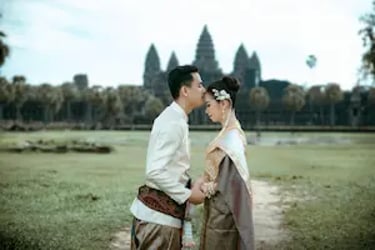
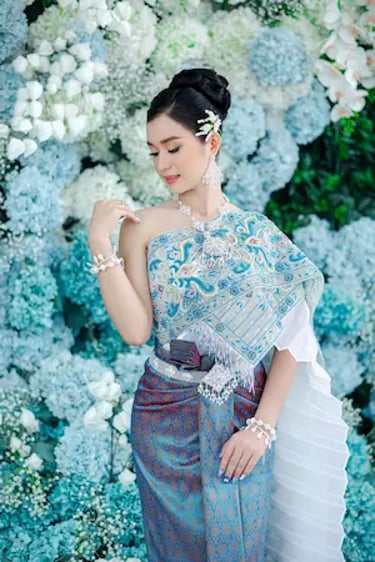
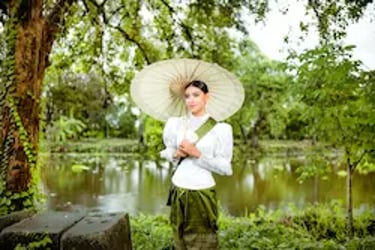
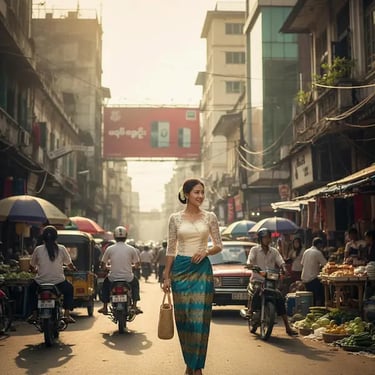
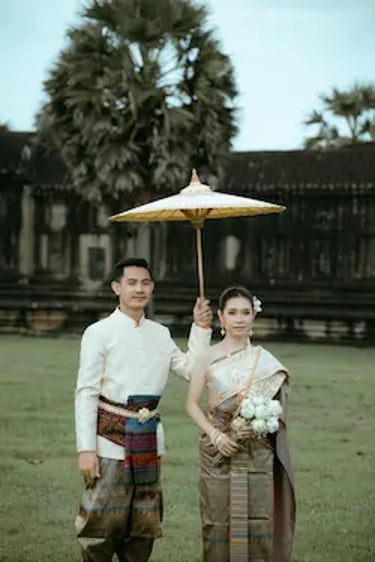
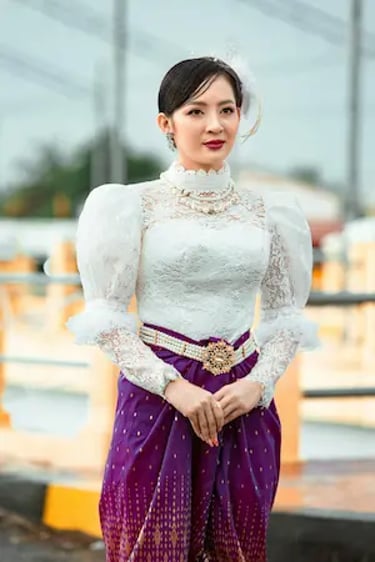
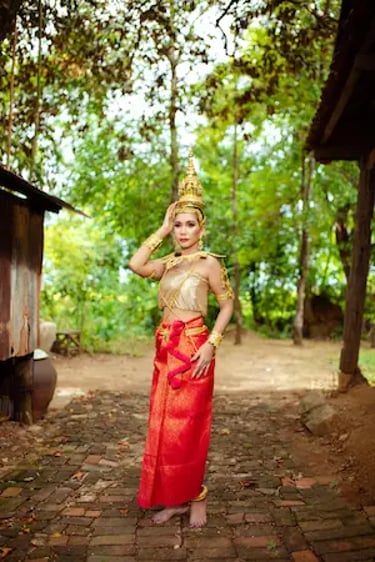
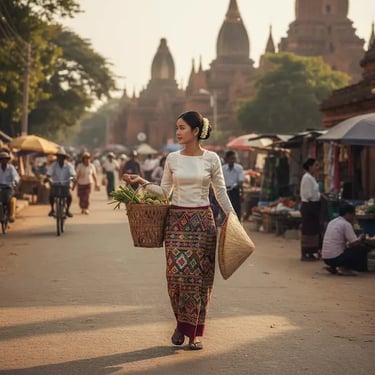








FAQ on Traditional Asian Costumes and Their Modern Adaptation
What fabrics are most commonly used in traditional Asian costumes?
You’ll often find linen, satin, velvet, and crepe, often combined with lace or embroidered pieces. These materials bring elegance and comfort depending on the region and season.
Are traditional Asian garments always embroidered?
Embroidery is widespread and often a symbol of prestige. Some outfits are entirely embroidered, while others remain simpler, such as a blouse, a white shirt, or a t-shirt.
What cuts are found in women’s outfits?
Women’s clothing includes the tunic, the blouse, shirts with long sleeves or short sleeves, sometimes sleeveless or with straps. Cuts range from fitted pieces to looser models, suitable for a wardrobe that works for all occasions.
What patterns are favored in traditional costumes?
Outfits often feature checks, stripes, or prints inspired by nature, along with richly embroidered fabrics.
Are there modern equivalents for women?
Yes, traditional outfits are reinterpreted into blouses, shirts, tunics, or even pants that can be paired with a scarf, sneakers, or a cardigan for a more casual look.
And for men, what can be found in traditional costumes?
Men’s clothing often includes linen or satin shirts, loose pants, sometimes worn with a tie or a cardigan. Modern jeans also blend into these styles, enriching the dressing room.
What fabrics are most commonly used in traditional Asian costumes?
You’ll often find linen, satin, velvet, viscose, and crepe, often combined with lace or embroidered pieces. These fabrics bring elegance, comfort, and sometimes a timeless appeal.
Are traditional Asian garments always embroidered?
Embroidery is very widespread and often synonymous with prestige. Some outfits are entirely embroidered, while others are simpler and plain, such as a blouse, a white shirt, or a tee-shirt.
What cuts are found in women’s outfits?
Women’s clothing includes the tunic, the blouse, the striped shirt, the denim shirt, as well as fitted, tailored, slim, straight-cut, and plus-size models. These adapt to different body types and to all occasions.
What patterns are favored in traditional costumes?
Outfits often feature checks, stripes, polka dots, or other printed versions inspired by nature. Some models are also more fanciful, with details such as ruffles or distinctive necklines.
Are there modern equivalents for women?
Yes, traditional outfits are reinterpreted as blouses, shirts, tunics, sweaters, tank tops, and skirts, sometimes complemented with a blazer, a suit, or a reimagined apron. Modern accessories such as scarves, heels, loafers, derbies, or even sneakers enrich the feminine wardrobe.
And for men, what can be found in traditional costumes?
Men’s clothing often includes linen shirts, striped, plain, or buttoned models, paired with high-waisted or straight-cut pants. Today, they are modernized with jeans, a cardigan, a knit sweater, or even a denim shirt for a more casual style.
How can these outfits be adapted to modern styles?
Fitted, slim, or tailored cuts create an elegant look, while casual styles suit everyday wear. A striped shirt or a crew-neck t-shirt pairs easily with a high-waisted skirt or khaki pants, completed with a blazer for a refined outfit.
What fabrics are most commonly used in traditional Asian costumes?
Traditional outfits are often made of linen, satin, velvet, crepe, or viscose, sometimes woven with textured details. These fabrics can be worn in both dresses and jackets, giving a balance of elegance and comfort.
Are traditional Asian garments always embroidered?
Embroidery is highly valued and often symbolizes prestige. While some garments are richly embroidered, others are more minimal, like a tee, a button down shirt, or a plain blouse that can easily be worn for everyday life.
What cuts are found in women’s outfits?
Women’s (womens) clothing includes the tunic, blouses, shirts, and dresses — from long-sleeve and button down versions to cropped, skinny, or oversized fits. Styles range from flattering midi and maxi cuts to leggings, shorts, and skirts, adaptable to different body types and occasions.
What patterns are favored in traditional costumes?
Popular patterns include stripe, plaid, checks, polka dots, or richly woven prints. These designs often carry cultural symbolism, while modern versions introduce more fashionable and styling options for today’s wardrobes.
Are there modern equivalents for women?
Yes — traditional garments can be worn as blouses, shirts, tees, polo tops, skirts, or dresses. They are often styled with blazers, coats, or outerwear like jackets and cardigans. Accessories such as sandals, sunglasses, hats, heels, or other footwear help complete a fashionable look.
And for men, what can be found in traditional costumes?
Men’s outfits often include button down shirts, down shirts, or polo shirts, paired with pants, shorts, or even twill-based outerwear. These garments can be styled with blazers, coats, or jackets, offering both elegant and casual looks depending on the occasion.
How can these outfits be adapted to modern styles?
With modern styling, traditional cuts can be worn with blazers, cropped jackets, or oversized coats. A V neck tee or a button down shirt pairs well with skinny jeans, a midi skirt, or tailored trousers. Adding sandals, moccasins, or other footwear, along with sunglasses, makes the look both practical and fashionable.
Travel
Asia Blog – Practical tips about Vietnam, Thailand, South Korea, Cambodia... visas, eSIMs, banking, travel budget, and more.
© 2025. All rights reserved.
